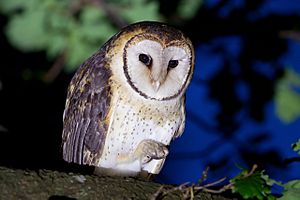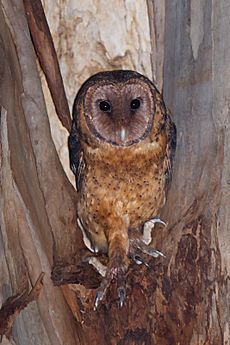Tasmanian masked owl facts for kids
Quick facts for kids Tasmanian masked owl |
|
|---|---|
 |
|
| Male | |
| Conservation status | |
| Scientific classification |
|
| Kingdom: | Animalia |
| Phylum: | Chordata |
| Class: | Aves |
| Order: | Strigiformes |
| Family: | Tytonidae |
| Genus: | Tyto |
| Species: | |
| Subspecies: |
T. n. castanops
|
| Trinomial name | |
| Tyto novaehollandiae castanops (Gould, 1837)
|
|
| Synonyms | |
|
|
The Tasmanian masked owl (Tyto novaehollandiae castanops) is a special type of owl. It belongs to the family of barn owls, called Tytonidae. This owl lives only in Tasmania, an island state in Australia.
It is the biggest kind of subspecies of the Australian masked owl. In fact, it's the largest Tyto owl in the whole world! Sometimes, people even think it should be its own separate species. Its name, castanops, means “chestnut-faced.” This is because of the color of its face.
A scientist named John Gould first described this owl in 1837. He wrote that it was very large and strong. He also said it was one of the most powerful birds, like an eagle. He noted that it lived in forests with big, spread-out trees. These owls are active at night. They fly quietly over open areas to find food like rats and other small animals.
Contents
About the Tasmanian Masked Owl
Tasmanian masked owls are not just big, they are also very strong. They look a lot like a barn owl, but they are much, much larger. Female owls can weigh up to 1.26 kilograms (2.8 pounds). Their wings can spread out to 129 centimeters (51 inches).
Their feathers are mostly a mix of brown and grey colors. They are usually darker than other Australian masked owls. The top parts of their bodies are dark brown to light chestnut. They also have small white spots. Female owls are much darker and bigger than males. Females are about 43 to 57 centimeters (17 to 22 inches) long. Males are smaller, about 35 to 42 centimeters (14 to 17 inches) long.
These owls have wide faces that are buff or chestnut colored. These faces have black edges. Their legs are fully covered in feathers. They also have strong feet and long, sharp claws.
Where They Live and Their Home
The Tasmanian masked owl lives only in Tasmania. People have seen them all over the island, except in the southwest. These owls live in both wet and dry eucalypt forests. They also live in woodlands and nearby farm areas.
They like to live near the edge of forests. These areas have different kinds of plants and trees. They need very large, old trees with big hollows inside for nesting. A pair of owls raising babies might use an area bigger than 10 square kilometers (3.9 square miles).
Important places for breeding include the east coast between Hobart and St Marys. Other areas are the Derwent and Huon Valleys. The mid-north coast is also important. There are also smaller areas in the Tamar Valley and the northeast coast. These owls have also been seen on Maria and Bruny Islands.
Some of these owls were also brought to Lord Howe Island. This island is in the Tasman Sea between Australia and New Zealand. On Lord Howe Island, they are considered an invasive species. This means they are not native and can harm the local animals.
Owl Behavior
These owls are very private and usually quiet. They are also strictly nocturnal, meaning they are active only at night. During the day, they rest. They usually roost in trees with thick leaves or in hollows. They also use rocky overhangs, caves, and sometimes farm sheds.
Reproduction and Life Cycle
Tasmanian masked owls breed in pairs. They are monogamous, meaning they stay with one partner. They also protect their territory. They build their nests in large tree hollows. The bottom of the nest is made of decaying wood.
The female owl lays 2 to 4 eggs. She sits on them for about 42 days to keep them warm. During this time, the male owl brings her food. When the chicks hatch, they are covered in white, then creamy, soft feathers called down. They learn to fly, or fledge, in 10 to 12 weeks. Young owls with some down feathers might stay near the nest for several weeks. Most eggs are laid in spring, from late October to early November.
The first detailed record of these owls being bred in captivity was in 1946. This happened at the Healesville Sanctuary in Victoria.
What They Eat
These owls hunt at night. They eat many different animals. This includes insects and mammals as big as rabbits. They also eat bandicoots and brushtail possums. In farm areas, their main food is introduced rodents and rabbits. In wilder places, they eat marsupials and native birds.
They often hunt from a high spot. They use their excellent hearing to find their prey. They usually catch their food on the ground. They strike with their feet and use their sharp talons to grab and kill.
Owl Calls
Tasmanian masked owls make a loud, rich, hissing or rasping screech. The female's call is deeper and harsher than the male's. They also snap their beaks loudly. This is a warning sign if they feel threatened.
Status and Conservation Efforts
In Tasmania
The Tasmanian masked owl is considered endangered in Tasmania. This is because there are not many of them left. Scientists estimate there are about 1330 breeding birds, or 615 pairs. Also, their habitat is being lost. This is especially true for old-growth forests, which they need for nesting.
It is important to protect their nesting places in forests where trees are harvested. The owls are also threatened by other animals competing for nest hollows. These include feral bees, kookaburras, and possums.
On Lord Howe Island
Between 1922 and 1930, nearly 100 masked owls were brought to Lord Howe Island. Most of them came from Tasmania. This was an attempt to control black rats, but it did not work. Now, the owls on Lord Howe Island are seen as a threat. They can harm the native Lord Howe woodhen, Lord Howe currawong, and breeding seabirds. Because of this, the owls are removed when possible.
Images for kids
See also
 In Spanish: Lechuza enmascarada de Tasmania para niños
In Spanish: Lechuza enmascarada de Tasmania para niños





